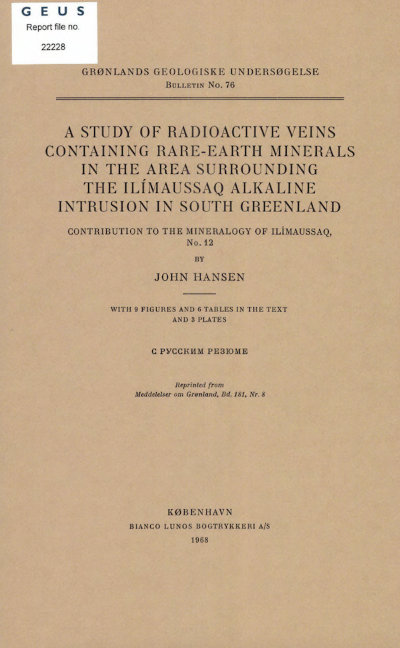A study of radioactive veins containing rare-earth minerals in the area surrounding the Ilímaussaq alkaline intrusion in South Greenland
DOI:
https://doi.org/10.34194/bullggu.v76.6616Abstract
Radioactive veins containing the rare-earth minerals monazite and bastnaesite are found in tension joints in Precambrian sandstone, granite, lavas and dykes on the eastern side of the alkaline Ilímaussaq intrusion in South Greenland. The veins were formed in several phases. First, small cracks were mineralized with hematite, fluorite, quartz and radioactive material. This was followed by emplacement of brown albititic veins in which albite and opaque material predominate, green veins with a high content of ægirine, white albititic veins, carbonate veins and finally quartz veins. All the vein minerals may be coated by a late iron-manganese oxide. Most often the veins are separate, but they may also occur composite. The veins are from a few millimetres to about three metres wide; most commonly they are one to ten centimetres wide. The radioactivity is mostly due to thorium, but a few veins have a uranium content higher than that of thorium. The thorium content ranges from 60 to 4500 ppm, the uranium from 17 to 1500 ppm. The ratio thorium/uranium ranges from 0.1 to 57.2. The radioactivity is predominantly connected with pigmentary material, thorite, thorianite, monazite and bastnäsite. Other minerals identified in the vein are ægirine, acmite, albite, arfvedsonite, apatite, biotite, calcite, chlorite, eudialyte, fluorite, hematite, lithium mica, mesodialyte, microcline, neptunite, pyrite, quartz and sphalerite. The following constants were calculated from X-ray powder diagrams made with a Guinier-Hagg camera.
Bastnäsite: a0 = 7.120 ± 7 x 10-3 Å; C0 = 9.77 ± 2 x 10-2 Å; c0/a0 = 1.372; V0 = 428.96 Å3. Monazite: a0 = 6.780 ± 5 x 10-3 Å; b0 = 7.025 ± 4 x 10-3 Å; C = 6.471 ± 4 x 10-3 Å; β = 103.35 ± 7 x 10-2; V0 = 299.84 Å3.
Micro-differential thermal analyses are given for bastnasite and thorite, thermoluminescence analyses are given for natural bastnasite and thorite and for artificially γ-radiated bastnäsite. Chemical, X-ray fluorescence and spectrochemical analyses are given for the different vein types. These analyses confirm the petrographical examination which has shown an erratic distribution of the rare-earth and radioactive minerals along and across the veins. It is suggested that the veins were formed at shallow depth and at low temperature.
Downloads
Published
Issue
Section
License
This article is distributed under a CC-BY 4.0 licence, permitting free redistribution and reproduction for any purpose, even commercial, provided proper citation of the original work. Author(s) retain copyright over the article contents.


